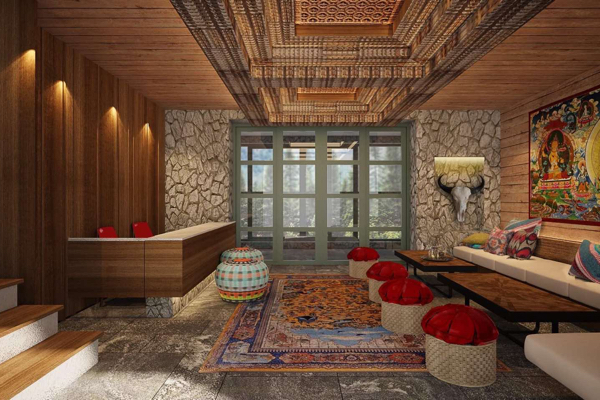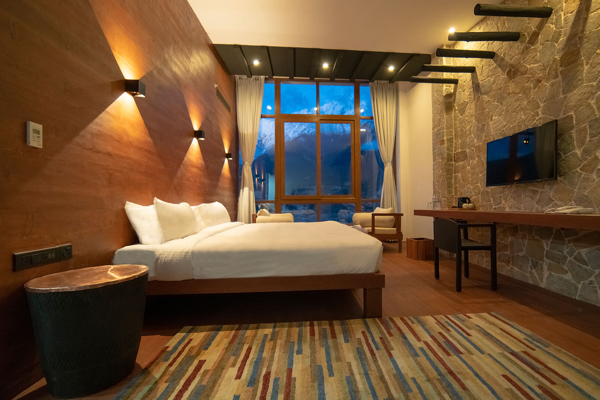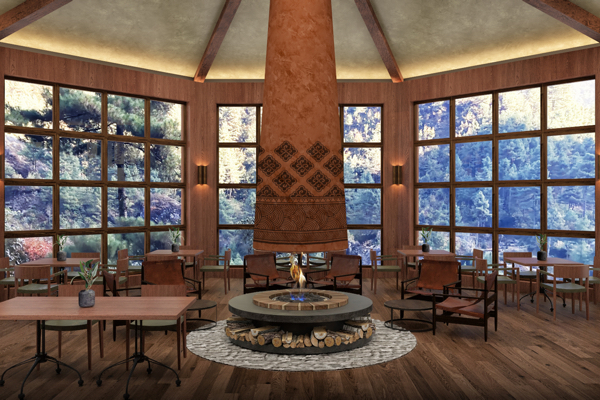Nepal’s high-profile Sherpa Hospitality Group has launched a new brand, Mountain Lodges of Nepal (MLN), which includes 15 family-owned, premium lodges offering treks along the Great Himalaya Trails.
The Sherpa family has been developing lodges for some 30 years and the brand launch acts as the further evolution of the former Yeti Mountain Home and Ker & Downey Nepal. In full, the group includes seven lodges in the Everest region and eight in Annapurna. The group will upgrade existing lodges to offer premium international hospitality experiences by adding new restaurants, building new lodges and adding mountain experiences.

At present, Sherpa Hospitality Group has 18 properties in total, and in 1Q23 will open the Shinta Mani Mustang – the first Shinta Mani Hotel outside of Cambodia. Other upcoming properties set to launch under MLN include new lodges in the Annapurna region.
Situated along the Dudh Koshi river 8,533 feet above sea level, Phakding Lodge is the first newly transformed lodge to be unveiled since the MLN brand’s debut. Also launching 1Q23, Deboche Lodge in the Everest region will be a new hotel by MLN built from the ground up to showcase the area as a new destination for adventure seekers.
The management company of Sherpa Hospitality was set up with J.M. Friedman & Co., whose founder Jason Friedman told HOTELS Nepal had a series of internal events, both political and natural, that negatively affected the global perception of the destination and set tourism back over the past decade.
“Now that the country has stabilized politically over the past couple of years, we see strong new interest and demand in the destination,” Friedman said. “With Bhutan announcing the new US$200 per day per person Sustainable Development Fee, we are seeing a shift in interest from there to Nepal and expect a big bump in business in 2023. The timing is just right for the launching of Mountain Lodges of Nepal and Shinta Mani Mustang. The New Nepal is here.”
To learn more about MLN, HOTELS recently spoke to Namgyal Sherpa, CEO of Sherpa Hospitality Group and a born mountaineer whose mother, the late Mrs. Pasang Lhamu Sherpa, was famously the first Nepali woman to summit Mount Everest. We also spoke to Jason Friedman of J.M. Friedman & Co. to get perspective on the marketplace.
HOTELS: Can you elaborate on why you have launched Mountain Lodges of Nepal?
Namgyal Sherpa: My goal has always been to build on what my family has created over the past 30 years. Now it’s about the overall quality of the experience and making the most luxurious lodge-to-lodge trekking journeys in the Nepali Himalaya.
My father and uncle created these circuits in the Annapurna and Everest regions that could be very difficult to set up today. It’s our goal to build on that by elevating the style, comfort hospitality levels, and food and beverage offerings.
Launching MLN was important because it gave a sense of hope and a new beginning coming out of COVID. It is an evolution from the old adventure comfort lodges concept to the new brand, a new team led by the young generation of Nepalis who are very much motivated and passionate to lead. It was challenging to invest during COVID because there was a lot of uncertainty around when things would go back to normal. However, we took a more bullish approach and speculated based on our research and consultation with our peers and decided to move ahead – this has turned out to be the right timing and we are happy with it.

H: What should the global hotel industry know/understand about Sherpa Hospitality?
NS: Sherpa Hospitality is the management company that J.M. Friedman & Co. worked with us to develop and establish. We saw a gap in our corporate structure and within Nepal hospitality at large as there were no boutique hospitality management companies in the country.
By consolidating our brands and leveraging our scattered hospitality resources in hotels, restaurants, food production, logistics, finance, sales, marketing, travel and adventure into one office we could create a leaner and more efficient business operation that could focus on the quality of experience in a more efficient way that would allow us to grow higher quality hospitality.
H: What are some of the highlights of the renovations?
NS: Seeing the lodges that I grew up in being renovated with a new style and comfort has been much more exciting than building all of the new lodges. Honestly, building the new lodges has been much easier than renovating the old ones. The highlight of the renovation is Phakding lodge, which we are re-building F&B and public areas situated on top of our old helipad overlooking the Dudh Koshi River. Of course, we had to also focus on the basics first. So, we are improvising our entire MEP services.

H: What are the biggest challenges of the development of the new brand?
NS: We worked with an amazing team from J.M. Friedman & Co. and Advant AI, a global branding agency. Together, they guided us through the process and made it fun.
The big challenge was getting the timing right as we were doing the MLN branding during the first year of COVID and were not sure when we should launch. Also, the switch from the old brands to new and the process.
H: Will there be growth outside Nepal for Sherpa Hospitality?
NS: The Himalayas are a vast region with most parts not easily accessible by tourists and lack any basic tourism infrastructure let alone at a luxury level.
We see a huge amount of opportunity to expand our different hospitality and supporting brands throughout the Himalayan region. Our expertise in developing, logistics and operating in remote areas is the key to our success as we look to expand.

H: What are some of the biggest challenges for development and growth?
Jason Friedman: Previously, our biggest challenges for growth were related to past political and social issues, and more recently the effects of the earthquake and COVID. With reduced demand for the country during that time, it was not an optimal time to invest in upgrading or building new products.
With a socially and politically stable country we saw an opportunity coming out of COVID and could see that Nepal was going to be a destination of choice for the leisure adventurer.
As with most other destinations in the region, our biggest challenge to growth is the international airlift. Once flights resume to 2019 levels, we expect business to be very strong. Our development pipeline is very strong with multiple new builds underway and the opening of Shinta Mani Mustang in March of 2023.
H: What is the longer-term strategy for further hotel development?
JF: We are very bullish about the future of tourism in the Nepali Himalaya. Our development pipeline is robust with multiple new properties under construction and development in the Everest and Annapurna regions for the Mountain Lodges of Nepal brand.
We are working with Bill Bensley and the Shinta Mani group to open the all-inclusive, luxury Shinta Mani Wild in Mustang on March 1, 2023. We are also developing a luxury lodge tour of Upper Mustang. With land secured in Dolpo and other remote areas of western Nepal we see the Mountain Lodges of Nepal brand extending throughout the Nepali Himalaya over the next several years, opening up entire new regions to premium and luxury trekking adventures.
H: Why are you working with Bill Bensley and Shinta Mani?
NS: My family was always familiar with Bill’s design work. When Jason from J.M. Friedman & Co., joined us he introduced us to Shinta Mani and brought my brother Sonu in to do a four-month internship at Shinta Mani Wild (in Cambodia). It was really my brother experiencing the Shinta Mani brand from the inside that made our family realize that they share the same vision for remote hospitality development, communities, philanthropy and conservation that we do. Bill Bensley and Shinta Mani seemed like the perfect fit for us and we could not be happier that the relationship prospered.
Last but not least, both Bill and Shinta Mani team loves Nepal.

H: What is your forecast for revenue growth across Sherpa Hospitality and then MLN?
NS: Coming out of COVID, we are expecting pre-COVID numbers for all our businesses under Sherpa Hospitality Group. It is looking healthy, and we are happy about it.
H: What is the state of competition in the marketplace?
JF: The trekking and adventure DMC space is quite crowded with many players, including our own DMC, Thamserku Trekking, which has been a leader in the industry for 30 years.
There is a lot less completion in the lodge space as we are the only operator to have seven lodge circuits in both the Everest and Annapurna regions. With the consolidation of these two regions under the Mountain Lodges of Nepal brand, we have become the dominant player in luxury lodge trekking circuits in the region. With a very positive outlook for the future, Sherpa Hospitality is investing heavily in renovations and the construction of new lodges across the region under the MLN brand.
H: What are the projected ADRs for renewed MLN projects?
NS: From US$250 per night plus tax and service (does not include Shinta Mani Mustang).
H: Describe the “new Nepal.”
NS: New Nepal is a mindset and also a vision for us to follow and live by. It’s about building on the past and for the future, but not forgetting the core. It’s about understanding and being up to date with the world. It’s about re-positioning Nepal as a luxury destination as opposed to the old budget and backpacking destinations. It’s about bringing in the young generations of team members, artists, chefs and leaders to create something meaningful and share it with the world. It’s about understanding the value of what we have, respecting the people, culture, nature and environment we operate in, and creating a positive impact.

